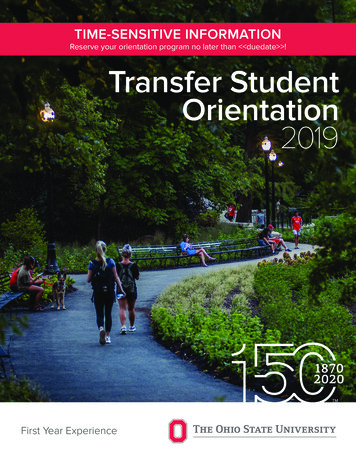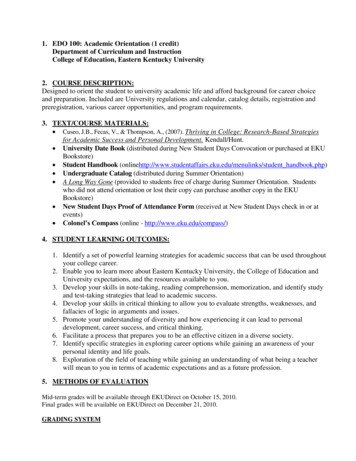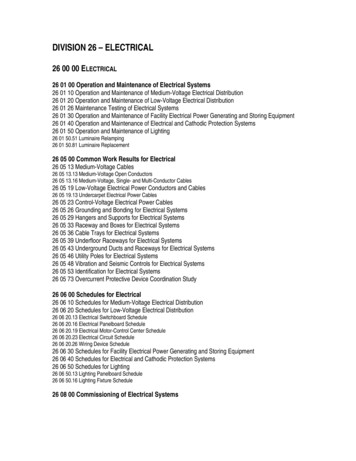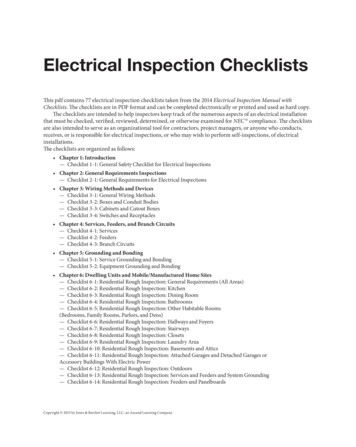
Transcription
Orientation to the Electrical TradeAnnotated Instructor’s GuideModule 26101-11Module OverviewThis module describes the different sectors in the electrical trade, and the types of work and work environments electricians would find in the field. It covers apprenticeship, training programs, and careeropportunities. The responsibilities and characteristics a worker should possess are also described.PrerequisitesPrior to training with this module, it is recommended that the trainee shall have successfully completedCore Curriculum.ObjectivesUpon completion of this module, the trainee will be able to do the following:1.2.3.4.5.Describe the apprenticeship/training process for electricians.Describe various career paths/opportunities one might follow in the electrical trade.Define the various sectors of the electrical industry.State the tasks typically performed by an electrician.Explain the responsibilities and aptitudes of an electrician.Performance TasksThis is a knowledge-based module. There are no Performance Tasks.Materials and EquipmentMultimedia projector and screenElectrical Level OnePowerPoint Presentation Slides(ISBN lkComputerPencils and scratch paperAppropriate personal protective equipmentCareers in Construction, 2006, NCCER/Pearson EducationCopies of the latest editions of the NEC andNFPA 70E standardsHelp-wanted section from an electrical tradepublicationSamples of NCCER Training CredentialsEmployee manualOSHA Safety and Health Standards for theConstruction Industry (29 CFR, Part 1926)TV/VCR/DVD player (optional)Module Examination** Single-module AIG purchases include the printed exam and performance task sheet. If you have purchased the perfect-bound version of this title, download these materials from the IRC using your accesscode.
Introduction to theNational Electrical Code Module 26105-11Annotated Instructor’s GuideModule OverviewThis module introduces trainees to the requirements and structure of the National Electrical Code .PrerequisitesPrior to training with this module, it is recommended that the trainee shall have successfully completedCore Curriculum; Electrical Level One, Modules 26101-11 through 26104-11.ObjectivesUpon completion of this module, the trainee will be able to do the following:1.2.3.4.5.Explain the purpose and history of the NEC .Describe the layout of the NEC .Demonstrate how to navigate the NEC .Describe the purpose of the National Electrical Manufacturers Association and the NFPA.Explain the role of nationally recognized testing laboratories.Performance TasksUnder the supervision of the instructor, the trainee should be able to do the following:1. Use NEC Article 90 to determine the scope of the NEC . State what is covered by the NEC and whatis not.2. Find the definition of the term feeder in the NEC .3. Look up the NEC specifications that you would need to follow if you were installing an outlet near aswimming pool.4. Find the minimum wire bending space required for two No. 1/0 AWG conductors installed in a junction box or cabinet and entering opposite the terminal.Materials and EquipmentMultimedia projector and screenElectrical Level OnePowerPoint Presentation Slides(ISBN ers/chalkPencils and scratch paperCopy of the latest edition of theNational Electrical Code Module Examination*Performance Profile Sheets** Single-module AIG purchases include the printed exam and performance task sheet. If you have purchased the perfect-bound version of this title, download these materials from the IRC using your accesscode.Additional ResourcesThis module presents thorough resources for task training. The following resource material is suggestedfor further study.National Electrical Code Handbook, Latest Edition. Quincy, MA: National Fire Protection Association.
Teaching Time for this ModuleAn outline for use in developing your lesson plan is presented below. Note that each Roman numeral inthe outline equates to one session of instruction. Each session has a suggested time period of 2½ hours.This includes 10 minutes at the beginning of each session for administrative tasks and one 10-minutebreak during the session. Approximately 7 ½ hours are suggested to cover Introduction to the NationalElectrical Code . You will need to adjust the time required for hands-on activity and testing based on yourclass size and resources. Because laboratories often correspond to Performance Tasks, the proficiency ofthe trainees may be noted during these exercises for Performance Testing purposes.TopicPlanned TimeSession I. Introduction to the NECA. IntroductionB. Purpose and History of the NEC C. The Layout of the NEC Session II. Navigating the NEC , Part OneA. Chapter 1 – GeneralB. Chapter 2 – Wiring and ProtectionC. Chapter 3 – Wiring Methods and MaterialsD. Chapter 4 – Equipment for General UseE. Chapter 5 – Special OccupanciesF. Chapters 6, 7, and 8 – Special Equipment, Special Conditions,and Communications SystemsSession III. Navigating the NEC , Part Two; Review and TestingA. Examples of Navigating the NEC B. Laboratory Have trainees practice using the NEC . This laboratory corresponds toPerformance Tasks 1–4.C. Other OrganizationsD. ReviewE. Module Examination1. Trainees must score 70% or higher to receive recognition from NCCER.2. Record the testing results on Training Report Form 200, and submit theresults to the Training Program Sponsor.F. Performance Testing1. Trainees must perform each task to the satisfaction of the instructor toreceive recognition from NCCER. If applicable, proficiency noted duringlaboratory exercises can be used to satisfy the Performance Testingrequirements.2. Record the testing results on Training Report Form 200, and submit theresults to the Training Program Sponsor.
Electrical TheoryAnnotated Instructor’s GuideModule 26104-11Module OverviewThis module introduces trainees to circuit calculations involving the application of Ohm’s and Kirchoff’slaws.PrerequisitesPrior to training with this module, it is recommended that the trainee shall have successfully completedCore Curriculum; Electrical Level One, Modules 26101-11 through 26103-11.ObjectivesUpon completion of this module, the trainee will be able to do the following:1. Explain the basic characteristics of combination circuits.2. Calculate, using Kirchhoff’s voltage law, the voltage drop in series, parallel, and series-parallelcircuits.3. Calculate, using Kirchhoff’s current law, the total current in parallel and series-parallel circuits.4. Using Ohm’s law, find the unknown parameters in series, parallel, and series-parallel circuits.Performance TasksThis is a knowledge-based module. There are no performance tasks.Materials and EquipmentElectrical Level OnePowerPoint Presentation Slides(ISBN 979-0-13-257126-5)Multimedia projector and ncils and scratch paperModule examination** Single-module AIG purchases include the printed exam and performance task sheet. If you have purchased the perfect-bound version of this title, download these materials from the IRC using your accesscode.Safety ConsiderationsEnsure that the trainees are equipped with appropriate personal protective equipment and know how touse it properly. Trainees may work with electrical test equipment. Make sure that all trainees are briefedon appropriate safety procedures. Emphasize electrical safety.Additional ResourcesThis module presents thorough resources for task training. The following resource material is suggestedfor further study.Electronics Fundamentals: Circuits, Devices, and Applications, Thomas L. Floyd. New York: Prentice Hall.Principles of Electric Circuits, Thomas L. Floyd. New York: Prentice Hall.
Teaching Time for This ModuleAn outline for use in developing your lesson plan is presented below. Note that each Roman numeral inthe outline equates to one session of instruction. Each session has a suggested time period of 2½ hours.This includes 10 minutes at the beginning of each session for administrative tasks and one 10-minutebreak during the session. Approximately 7 ½ hours are suggested to cover Electrical Theory. You will needto adjust the time required for hands-on activity and testing based on your class size and resources.TopicSession I. Introduction; Resistive CircuitsA. IntroductionB. Resistances in SeriesC. Resistances in ParallelD. Series-Parallel CircuitsSession II. Applying Ohm’s Law to Resistive CircuitsA. Voltage and Current in Series CircuitsB. Voltage and Current in Parallel CircuitsC. Voltage and Current in Series-Parallel CircuitsSession III. Kirchhoff’s Law; Review and TestingA. Kirchhoff’s LawB. Module ReviewC. Module Examination1. Trainees must score 70% or higher to receive recognition from NCCER.2. Record the testing results on Training Report Form 200, and submit theresults to the Training Program Sponsor.Planned Time
Introduction to Electrical CircuitsAnnotated Instructor’s GuideModule 26103-11Module OverviewThis module introduces the trainee to electrical circuits. It offers a general introduction to electrical concepts used in Ohm’s law. It includes atomic theory, electromagnetic force, resistance, and electric powerequations. It also covers series, parallel, and series-parallel circuits.PrerequisitesPrior to training with this module, it is recommended that the trainee shall have successfully completedCore Curriculum; Electrical Level One, Modules 26101-11 and 26102-11.ObjectivesUpon completion of this module, the trainee will be able to do the following:1.2.3.4.5.Define voltage and identify the ways in which it can be produced.Explain the difference between conductors and insulators.Define the units of measurement that are used to measure the properties of electricity.Identify the meters used to measure voltage, current, and resistance.Explain the basic characteristics of series and parallel circuits.Performance TasksThis is a knowledge-based module. There are no performance tasks.Materials and EquipmentMultimedia projector and screenElectrical Level OnePowerPoint Presentation Slides(ISBN kers/chalkPencils and scratch paperSample schematicsBasic electrical circuit, including:Battery/power sourceWiringLoadsSwitchesExamples of conductors, insulators, andcolor-coded resistorsMagnetsSimple electromagnetMetal sheetIron filingsVarious types of meters, including:MultimeterVoltmeterClamp-on ammeterOhmmeterContinuity testerVoltage testerModule Examination** Single-module AIG purchases include the printed exam and performance task sheet. If you have purchased the perfect-bound version of this title, download these materials from the IRC using your accesscode.Safety ConsiderationsEnsure that the trainees are equipped with appropriate personal protective equipment and know how touse it properly. Trainees may work with electrical test equipment. Make sure that all trainees are briefedon appropriate safety procedures. Emphasize electrical safety.
Additional ResourcesThis module presents thorough resources for task training. The following resource material is suggestedfor further study.Electronics Fundamentals: Circuits, Devices, and Applications, Thomas L. Floyd. New York: Prentice Hall.Principles of Electric Circuits, Thomas L. Floyd. New York: Prentice Hall.Teaching Time for This ModuleAn outline for use in developing your lesson plan is presented below. Note that each Roman numeral inthe outline equates to one session of instruction. Each session has a suggested time period of 2½ hours.This includes 10 minutes at the beginning of each session for administrative tasks and one 10- minutebreak during the session. Approximately 7½ hours are suggested to cover Introduction to ElectricalCircuits. You will need to adjust the time required for hands-on activity and testing based on your classsize and resources.TopicSession I. Introduction to Electrical TheoryA. IntroductionB. Atomic TheoryC. Electrical Power Generation and DistributionD. Electric Charge and CurrentSession II. Ohm’s Law; Schematics; MeasurementsA. Ohm’s LawB. Schematic Representation of Circuit ElementsC. ResistorsD. Electrical CircuitsE. Electrical Measuring InstrumentsSession III. Power Equations; Review and TestingA. Electrical PowerB. Module ReviewC. Module Examination1. Trainees must score 70% or higher to receive recognition from NCCER.2. Record the testing results on Training Report Form 200, and submit theresults to the Training Program Sponsor.Planned Time
Electrical SafetyAnnotated Instructor’s GuideModule 26102-11Module OverviewThis module introduces the trainees to the safety rules and regulations for electricians, including thenecessary precautions for avoiding various job site hazards.PrerequisitesPrior to training with this module, it is recommended that the trainee shall have successfully completedCore Curriculum; Electrical Level One, Module 26101-11.ObjectivesUpon completion of this module, the trainee will be able to do the following:1.2.3.4.Recognize safe working practices in the construction environment.Explain the purpose of OSHA and how it promotes safety on the job.Identify electrical hazards and how to avoid or minimize them in the workplace.Explain electrical safety issues concerning lockout/tagout procedures, confined space entry, respiratory protection, and fall protection systems.5. Develop a task plan and a hazard assessment for a given task and select the appropriate PPE and workmethods to safely perform the task.Performance TasksUnder the supervision of the instructor, the trainee should be able to do the following:1.2.3.4.Perform a visual inspection on various types of ladders.Set up a ladder properly to perform a task.Properly don a harness.Perform a hazard assessment of a job such as replacing the lights in your classroom. Discuss the work to be performed and the hazards involved. Locate the phone closest to the work site and ensure that the local emergency telephone numbersare either posted at the phone or known by you and your partner(s). Plan an escape route from the location in the event of an accident.Materials and EquipmentMultimedia projector and screenElectrical Level OnePowerPoint Presentation Slides(ISBN kers/chalkPencils and scratch paperCopy of the latest edition of the NationalElectrical Code OSHA Electrical Safety Guidelines (pocket guide)NFPA 70E Company safety manualSolvent MSDSAccess to eye wash stationVarious types of personal protective and safetyequipment, including:Rubber glovesInsulating blanketsHot sticksFuse pullersShorting probesSafety glassesFace shieldsHard hatsGFCI deviceCompany lockout/tagout proceduresLockout/tagout devices and labelsStepladdersStraight ladders(continued)
Fall arrest systemSafety harnessesTV/DVD/VCR player (optional)Safety videos (optional)Module Examination*Performance Profile Sheet** Single-module AIG purchases include the printed exam and performance task sheet. If you have purchasedthe perfect-bound version of this title, download these materials from the IRC using your access code.Safety ConsiderationsEnsure that the trainees are equipped with appropriate personal protective equipment and know how touse it properly. This module requires trainees to work with ladders. Make sure that all trainees are briefedon appropriate safety procedures. Emphasize electrical safety.Additional ResourcesThis module presents thorough resources for task training. The following resource material is suggestedfor further study.29 CFR Parts 1900–1910, Standards for General Industry. Occupational Safety and Health Administration,U.S. Department of Labor.29 CFR Part 1926, Standards for the Construction Industry. Occupational Safety and Health Administration,U.S. Department of Labor.National Electrical Code Handbook, Latest Edition. Quincy, MA: National Fire Protection Association.Standards for Electrical Safety in the Workplace, Latest Edition. Quincy, MA: National Fire ProtectionAssociation.Managing Electrical Hazards, 2009, NCCER/Pearson Education.Teaching Time for this ModuleAn outline for use in developing your lesson plan is presented below. Note that each Roman numeral inthe outline equates to one session of instruction. Each session has a suggested time period of 2½ hours.This includes 10 minutes at the beginning of each session for administrative tasks and one 10-minutebreak during the session. Approximately 10 hours are suggested to cover Electrical Safety. You will need toadjust the time required for hands-on activity and testing based on your class size and resources. Becauselaboratories often correspond to Performance Tasks, the proficiency of the trainees may be noted duringthese exercises for Performance Testing purposes.TopicSession I. Introduction; Electrical HazardsA. IntroductionB. Electrical ShockC. Protective EquipmentD. OSHAE. NFPA 70E Session II. Ladders, Lifts, and LiftingA. Ladders and ScaffoldsB. Laboratory Have trainees practice visually inspecting ladders. This laboratory correspondsto Performance Task 1.C. Laboratory Have trainees practice setting up a ladder. This laboratory corresponds toPerformance Task 2.D. Lifts, Hoists, and CranesE. LiftingF. Basic Tool SafetyPlanned Time
Session III. General Construction Safety TopicsA. Confined Space Entry ProceduresB. First AidC. Solvents and Toxic VaporsD. Asbestos, Batteries, PCBs, and Vapor LampsSession IV. Lead Safety; Fall Protection; Hazard Assessment; Review and TestingA. Lead SafetyB. Fall ProtectionC. Laboratory Have trainees practice donning a safety harness. This laboratory corresponds toPerformance Task 3.D. Hazard AssessmentE. Laboratory Have trainees practice performing a hazard assessment. This laboratorycorresponds to Performance Task 4.F. ReviewG. Module Examination1. Trainees must score 70% or higher to receive recognition from NCCER.2. Record the testing results on Training Report Form 200, and submitthe results to the Training Program Sponsor.H. Performance Testing1. Trainees must perform each task to the satisfaction of the instructor toreceive recognition from NCCER. If applicable, proficiency noted duringlaboratory exercises can be used to satisfy the Performance Testingrequirements.2. Record the testing results on Training Report Form 200, and submitthe results to the Training Program Sponsor.
Additional ResourcesThis module presents thorough resources for task training. The following resource material is suggestedfor further study.National Electrical Code Handbook, Latest Edition. Quincy, MA: National Fire Protection Association.Safety videos or DVDs can often be obtained free of charge from professional associations, tradeassociations, or university safety offices. The following safety training videos are available free ofcharge at the OSHA website (www.osha.gov):Partner with OSHA: New Ways of Working. OSHA Video (2001), 11 minutes.Protecting Workers: How OSHA Conducts Inspections. OSHA Video (1994), 18 minutes.Protecting Workers: How OSHA Writes Standards. OSHA Video (1992), 12 minutes.Construction Safety: Choice or Chance. OSHA Video (2000), 15 minutes.Teaching Time for this ModuleAn outline for use in developing your lesson plan is presented below. Note that each Roman numeral inthe outline equates to one session of instruction. Each session has a suggested time period of 2½ hours.This includes 10 minutes at the beginning of each session for administrative tasks and one 10-minutebreak during the session. Approximately 2½ hours are suggested to cover Orientation to the ElectricalTrade. You will need to adjust the time required for hands-on activity and testing based on your class sizeand resources.TopicPlanned TimeSession I. Introduction; The Electrical Trade; Review and TestingA. IntroductionB. Career Opportunities in the Electrical FieldC. Your Training ProgramD. Responsibilities of the EmployeeE. Responsibilities of the EmployerF. SafetyG. ReviewH. Module Examination1. Trainees must score 70% or higher to receive recognition from NCCER.2. Record the testing results on Training Report Form 200, and submitthe results to the Training Program Sponsor.
Device BoxesAnnotated Instructor’s GuideModule 26106-11Module OverviewThis module explains how to select and size outlet boxes, pull boxes, and junction boxes pursuant toNEC requirements.PrerequisitesPrior to training with this module, it is recommended that the trainee shall have successfully completedCore Curriculum; Electrical Level One, Modules 26101-11 through 26105-11.ObjectivesUpon completion of this module, the trainee will be able to do the following:1.2.3.4.Describe the different types of nonmetallic and metallic boxes.Calculate the NEC fill requirements for boxes under 100 cubic inches.Identify the appropriate box type and size for a given application.Select and demonstrate the appropriate method for mounting a given box.Performance TasksUnder the supervision of the instructor, the trainee should be able to do the following:1. Identify the appropriate box type and size for a given application.2. Select the minimum size pull or junction box for the following applications: Conduit entering and exiting for a straight pull. Conduit entering and exiting at an angle.Materials and EquipmentMultimedia projector and screenElectrical Level OnePowerPoint Presentation Slides(ISBN kers/chalkPencils and scratch paperConduit capsCopy of the latest edition of the NationalElectrical Code Examples of different types of metallic andnonmetallic boxes, device covers, andextension ringsExamples of pull and junction boxesExamples of device boxesWire nutsStripping toolsWireModule Examination*Performance Profile Sheets** Single-module AIG purchases include the printed exam and performance task sheet. If you have purchased the perfect-bound version of this title, download these materials from the IRC using your accesscode.Safety ConsiderationsEnsure that the trainees are equipped with appropriate personal protective equipment and know howto use it properly. Trainees may work with device boxes. Make sure that all trainees are briefed on appropriate safety procedures. Emphasize electrical safety.
Additional ResourcesThis module presents thorough resources for task training. The following resource material is suggestedfor further study.American Electrician’s Handbook, Latest Edition. New York: Croft and Summers, McGraw-Hill.National Electrical Code Handbook, Latest Edition. Quincy, MA.: National Fire Protection Association.Teaching Time for this ModuleAn outline for use in developing your lesson plan is presented below. Note that each Roman numeral inthe outline equates to one session of instruction. Each session has a suggested time period of 2½ hours.This includes 10 minutes at the beginning of each session for administrative tasks and one 10-minutebreak during the session. Approximately 10 hours are suggested to cover Device Boxes. You will need toadjust the time required for hands-on activity and testing based on your class size and resources. Becauselaboratories often correspond to Performance Tasks, the proficiency of the trainees may be noted duringthese exercises for Performance Testing purposes.TopicPlanned TimeSession I. Introduction to Device BoxesA. IntroductionB. Types of BoxesSession II. Sizing Outlet BoxesA. Sizing Outlet BoxesB. LaboratoryHave trainees practice identifying the appropriate type and size of box for agiven application. This laboratory corresponds to Performance Task 1.C. Pull and Junction BoxesD. LaboratoryHave trainees practice selecting the minimum size pull or junction box.This laboratory corresponds to Performance Task 2.Session III. Installing BoxesA. NEC RequirementsB. Making ConnectionsSession IV. Review and TestingA. Module ReviewB. Module Examination1. Trainees must score 70% or higher to receive recognition from NCCER.2. Record the testing results on Training Report Form 200, and submit theresults to the Training Program Sponsor.C. Performance Testing1. Trainees must perform each task to the satisfaction of the instructor toreceive recognition from NCCER. If applicable, proficiency noted duringlaboratory exercises can be used to satisfy the Performance Testingrequirements.2. Record the testing results on Training Report Form 200, and submit theresults to the Training Program Sponsor.
Hand BendingAnnotated Instructor’s GuideModule 26107-11Module OverviewThis module introduces trainees to the methods and procedures used in cutting, bending, and reamingconduit.PrerequisitesPrior to training with this module, it is recommended that the trainee shall have successfully completedCore Curriculum; Electrical Level One, Modules 26101-11 through 26106-11.ObjectivesUpon completion of this module, the trainee will be able to do the following:1.2.3.4.Identify the methods for hand bending and installing conduit.Determine conduit bends.Make 90 bends, back-to-back bends, offsets, kicks, and saddle bends using a hand bender.Cut, ream, and thread conduit.Performance TasksUnder the supervision of the instructor, the trainee should be able to do the following:1. Make 90 bends, back-to-back bends, offsets, kicks, and saddle bends using a hand bender.2. Cut, ream, and thread conduit.Materials and EquipmentMultimedia projector and screenElectrical Level OnePowerPoint Presentation Slides(ISBN kers/chalkPencils and scratch paperAppropriate personal protective equipmentCopy of the latest edition of the NationalElectrical Code OSHA Electrical Safety Guidelines (pocket edition)Hand bender and manufacturer’sinstructionsVarious pieces of conduitHickey barManufacturers’ gain tablesNo. 10 or No. 12 solid wireTape measureCalculatorHacksawPipe visePipe cutterReamerCutting oilShop towelsHand-operated threaderSandbox or drip panTorpedo levelPVC piecesPVC cementsModule Examination*Performance Profile Sheets** Single-module AIG purchases include the printed exam and performance task sheet. If you have purchased the perfect-bound version of this title, download these materials from the IRC using your accesscode.Safety ConsiderationsEnsure that the trainees are equipped with appropriate personal protective equipment and know how touse it properly. This module requires trainees to cut and bend pipe. Make sure that all trainees are briefedon appropriate safety procedures. Emphasize hand tool safety.
Additional ResourcesThis module presents thorough resources for task training. The following resource material is suggestedfor further study.Benfield Conduit Bending Manual, 2nd Edition. Overland Park, KS: EC&M Books.National Electrical Code Handbook, Latest Edition. Quincy, MA: National Fire Protection Association.Tom Henry’s Conduit Bending Package (includes video, book, and bending chart). Winter Park, FL: CodeElectrical Classes, Inc.Teaching Time for this ModuleAn outline for use in developing your lesson plan is presented below. Note that each Roman numeral inthe outline equates to one session of instruction. Each session has a suggested time period of 2½ hours.This includes 10 minutes at the beginning of each session for administrative tasks and one 10-minutebreak during the session. Approximately 10 hours are suggested to cover Hand Bending. You will need toadjust the time required for hands-on activity and testing based on your class size and resources. Becauselaboratories often correspond to Performance Tasks, the proficiency of the trainees may be noted duringthese exercises for Performance Testing purposes.TopicSession I. Introduction to Hand BendingA. IntroductionB. Hand Bending EquipmentC. Geometry Required to Make a BendD. Making a 90 BendE. Laboratory Have trainees practice making 90 bends. This laboratory corresponds toPerformance Task 1.F. Back-to-Back BendsG. Laboratory Have trainees practice making back-to-back bends. This laboratory correspondsto Performance Task 1.Session II. Offset and Saddle BendsA. Making an OffsetB. Parallel OffsetsC. Laboratory Have trainees practice making offset bends. This laboratory corresponds toPerformance Task 1.D. Saddle BendsE. Laboratory Have trainees practice making saddle bends. This laboratory corresponds toPerformance Task 1.Session III. Joining ConduitA. Cutting, Reaming, and Threading ConduitB. Laboratory Have trainees practice cutting, reaming, and threading conduit. This laboratorycorresponds to Performance Task 2.C. Cutting and Joining PVC ConduitPlanned Time
Session IV. Review and TestingA. ReviewB. Module Examination1. Trainees must score 70% or higher to receive recognition from NCCER.2. Record the testing results on Training Report Form 200, and submitthe results to the Training Program Sponsor.C. Performance Testing1. Trainees must perform each task to the satisfaction of the instructorto receive recognition from NCCER. If applicable, proficiency notedduring laboratory exercises can be used to satisfy the PerformanceTesting requirements.2. Record the testing results on Training Report Form 200, and submitthe results to the Training Program Sponsor.
Raceways and FittingsAnnotated Instructor’s GuideModule 26108-11Module OverviewThis module introduces types and applications of raceways, wireways, and ducts. It stresses the appropriate NEC requirements.PrerequisitesPrior to training with this module, it is recommended that the trainee shall have successfully completedCore Curriculum; Electrical Level One, Modules 26101-11 through 26107-11.ObjectivesUpon completion of this module, the trainee will be able to do the following:1.2.3.4.5.6.Identify and select various types and sizes of raceways and fittings for a given application.Identify various methods used to fabricate (join) and install raceway systems.Identify uses permitted for selected raceways.Dem
National Electrical Code Handbook, Latest Edition. Quincy, MA: National Fire Protection Association. Introduction to the National Electrical Code Annotated Instructor’s Guide Module 26105-11 Module Overview This module introduces trainees to the requirements and struc










